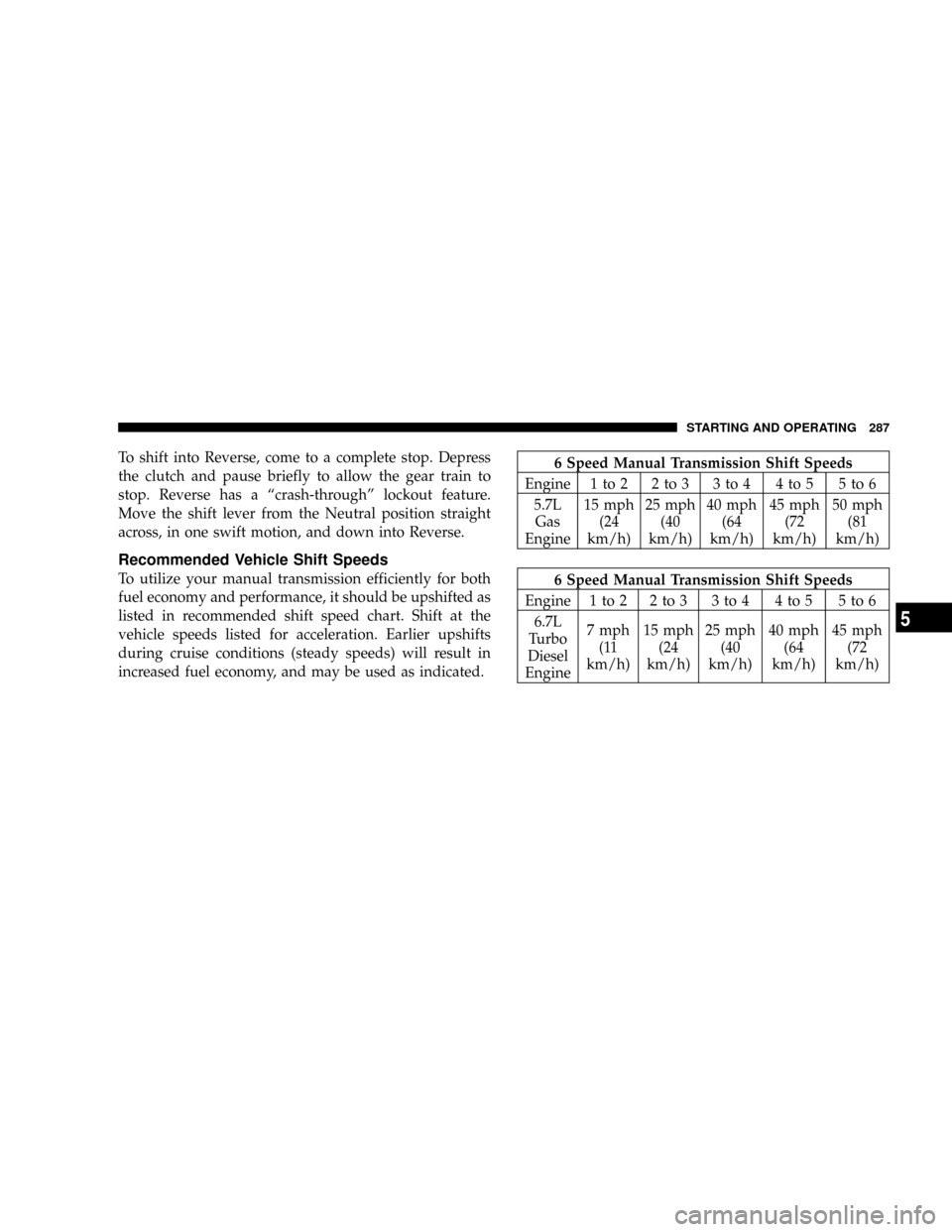Page 266 of 528

If temperatures are below 32ÉF (0ÉC), operate the engine
at moderate speeds for 5 minutes before full loads are
applied.
Engine Idling Ð In Cold Weather
Avoid prolonged idling in ambient temperatures below
0ÉF. Long periods of idling may be harmful to your
engine because combustion chamber temperatures can
drop so low that the fuel may not burn completely.
Incomplete combustion allows carbon and varnish to
form on piston rings and injector nozzles. Also, the
unburned fuel can enter the crankcase, diluting the oil
and causing rapid wear to the engine. Excessive idle time
can also cause damage to the engine exhaust aftertreat-
ment system.
NOTE:An optional driver-controlled high idle speed is
available on automatic transmission equipped vehicleswith speed control. This feature allows the driver to
select an elevated idle speed between 1100 and 1500
rpms. Your dealer can enable this feature.
NOTE:²If ambient temperatures are low and the coolant
temperature is below 200ÉF (93ÉC), the engine idle
speed will slowly increase to 1000 RPM after 2 minutes
of idle, if the following conditions are met:
²foot is off brake pedal and throttle pedal
²automatic transmission is in Park (P)
²vehicle speed is zero
²Applying the throttle will cancel fast idle
²If the engine is equipped with an exhaust brake,
operating the exhaust brake at idle will greatly im-
prove warm up rate and will help keep the engine
close to operating temperature during extended idle.
266 STARTING AND OPERATING
Page 268 of 528

Engine Speed Control
CAUTION!
Prevent overspeeding the engine going down hill.
When descending steep grades, use a combination of
gears and service brakes to control vehicle/engine
speed. Overspeed can cause severe engine damage.
Operating Precautions
Avoid Overheating The Engine
The temperature of the coolant (a mixture of 50%
ethylene-glycol and 50% water) must not exceed the
normal range of the temperature gauge (240ÉF/116ÉC)
with a 16 psi (110 kPa) radiator cap.
Usually the coolant temperature indicated during opera-
tion will be to the left of center in the normal range of the
gauge.
Avoid Low Coolant Temperature Operation
Continual operation at low coolant temperature below
the normal range on the gauge (140ÉF/60ÉC) can be
harmful to the engine. Low coolant temperature can
cause incomplete combustion which allows carbon and
varnish to form on piston rings and injector nozzles.
Also, the unburned fuel can enter the crankcase, diluting
the lubricating oil and causing rapid wear to the engine.
Cooling System Tips Ð Automatic Transmission
To reduce potential for engine and transmission over-
heating in high ambient temperature conditions, take the
following actions:
²City Driving Ð
when stopped, put transmission in neutral and increase
engine idle speed.
²Highway Driving Ð
reduce your speed.
268 STARTING AND OPERATING
Page 269 of 528

²Up Steep Hills Ð
select a lower transmission gear, but try and keep the
torque converter clutch engaged.
²Air Conditioning Ð
turn it off temporarily.
Do Not Operate The Engine With Low Oil
Pressure
When the engine is at normal operating temperature, the
minimum oil pressures required are:
Idle 700 to 800 RPM............... 10psi(69kPa)
Full speed and load.............. 30psi(207 kPa)
CAUTION!
If oil pressure falls to less than normal readings, shut
the engine off immediately. Failure to do so could
result in immediate and severe engine damage.
Do Not Operate The Engine With Failed Parts
Practically all failures give some warning before the parts
fail. Be on the alert for changes in performance, sounds,
and visual evidence that the engine requires service.
Some important clues are:
²engine misfiring or vibrating severely
²sudden loss of power
²unusual engine noises
²fuel, oil or coolant leaks
²sudden change, outside the normal operating range, in
the engine operating temperature
²excessive smoke
²oil pressure drop
STARTING AND OPERATING 269
5
Page 278 of 528

reduce the potential for transmission overheating or
failure due to excessive shifting. When operating in
ªTOW HAULº mode, 5th gear is disabled and 2-3 and 3-4
shift patterns are modified. Shifts into Overdrive (4th
gear) are allowed during steady cruise (for improved fuel
economy) and automatic closed-throttle downshifts to
3rd gear (for improved braking) will occur during steady
braking. Pressing the ªTOW HAUL O/D OFFº button a
second time to select O/D OFF will disable 4th and 5th
gear completely, which should eliminate any excessive
transmission shifting.
The ªTOW HAULº or ªO/D OFFº light will illuminate in
the instrument cluster to indicate when the switch has
been activated. Pressing the switch a third time restores
normal operation. If the ªTOW HAULº or ªO/D OFFº
modes are desired, the button must be pressed each time
the engine is started.When To Lock Out Overdrive
When driving in hilly areas, towing a trailer, carrying a
heavy load, etc., and frequent 4±3±4 transmission shifting
occurs, press the ªTOW/HAULº button twice to disable
the overdrive. This will improve performance and reduce
the potential for transmission overheating or failure due
to excessive shifting.
Torque Converter Clutch
A feature, designed to improve fuel economy, has been
included in the automatic transmission on your vehicle.
A clutch within the torque converter engages automati-
cally at calibrated speeds. This may result in a slightly
different feeling or response during normal operation in
high gear. When the vehicle speed drops or during
acceleration when the transmission downshifts to second
gear, the clutch automatically disengages.
278 STARTING AND OPERATING
Page 284 of 528

reduce the potential for transmission overheating or
failure due to excessive shifting. When operating in
ªTOW HAULº mode, 6th gear (if equipped) is disabled
and 2-3 and 3-4 and 4±5 shift patterns are modified. Shifts
into Overdrive (5th gear) are allowed during steady
cruise (for improved fuel economy). Pressing the ªTOW
HAUL O/D OFFº button a second time to select O/D
OFF will disable 5th and 6th gear completely, which
should eliminate any excessive transmission shifting.
The ªTOW HAULº or ªO/D OFFº light will illuminate in
the instrument cluster to indicate when the switch has
been activated. Pressing the switch a third time restores
normal operation. If the ªTOW HAULº or ªO/D OFFº
modes are desired, the button must be pressed each time
the engine is started.WARNING!
Do not use the Tow/Haul feature when driving in icy
or slippery conditions as the increased engine brak-
ing can cause the rear wheels to slide and the vehicle
to swing around with the possible loss of vehicle
control, which may cause an accident possibly result-
ing in personal injury or death.
When To Lock Out Overdrive
When driving in hilly areas, towing a trailer, carrying a
heavy load, etc., and frequent 6±5±6 or 5±4±5 transmis-
sion shifting occurs, press the ªTOW/HAULº button.
This will improve performance and reduce the potential
for transmission overheating or failure due to excessive
shifting.
284 STARTING AND OPERATING
Page 285 of 528

Torque Converter Clutch
A feature, designed to improve fuel economy, has been
included in the automatic transmission on your vehicle.
A clutch within the torque converter engages automati-
cally at calibrated speeds. This may result in a slightly
different feeling or response during normal operation in
high gear. When the vehicle speed drops or during
acceleration when the transmission downshifts to 1st
gear, the clutch automatically disengages.
NOTE:The torque converter clutch will not engage
until the transmission fluid and engine coolant are warm
[usually after 1-3 miles (1.6 - 4.8 km) of driving]. Because
the engine speed is higher when the torque converter
clutch is not engaged, it may seem as if the transmission
is not shifting into Overdrive when cold. This is normal.
Pressing the ªTOW/HAULº button, when the transmis-
sion is sufficiently warm, will demonstrate that the
transmission is able to shift into and out of overdrive.NOTE:If the vehicle has not been driven in several
days, the first few seconds of operation after shifting the
transmission into gear may seem sluggish. This is due to
the fluid partially draining from the torque converter into
the transmission. This condition is normal and will not
cause damage to the transmission. The torque converter
will refill within five seconds of shifting from Park into
any other gear position.
MANUAL TRANSMISSION
WARNING!
You or others could be injured if you leave the
vehicle unattended without having the parking
brake fully applied. The parking brake should al-
ways be applied when the driver is not in the vehicle,
especially on an incline.
STARTING AND OPERATING 285
5
Page 287 of 528

To shift into Reverse, come to a complete stop. Depress
the clutch and pause briefly to allow the gear train to
stop. Reverse has a ªcrash-throughº lockout feature.
Move the shift lever from the Neutral position straight
across, in one swift motion, and down into Reverse.
Recommended Vehicle Shift Speeds
To utilize your manual transmission efficiently for both
fuel economy and performance, it should be upshifted as
listed in recommended shift speed chart. Shift at the
vehicle speeds listed for acceleration. Earlier upshifts
during cruise conditions (steady speeds) will result in
increased fuel economy, and may be used as indicated.
6 Speed Manual Transmission Shift Speeds
Engine 1 to 2 2 to 3 3 to 4 4 to 5 5 to 6
5.7L
Gas
Engine15 mph
(24
km/h)25 mph
(40
km/h)40 mph
(64
km/h)45 mph
(72
km/h)50 mph
(81
km/h)
6 Speed Manual Transmission Shift Speeds
Engine 1 to 2 2 to 3 3 to 4 4 to 5 5 to 6
6.7L
Turbo
Diesel
Engine7 mph
(11
km/h)15 mph
(24
km/h)25 mph
(40
km/h)40 mph
(64
km/h)45 mph
(72
km/h)
STARTING AND OPERATING 287
5
Page 323 of 528
2. EconomyÐ
Improper inflation pressures can cause uneven wear
patterns to develop across the tire tread. These abnormal
wear patterns will reduce tread life resulting in a need for
earlier tire replacement. Under inflation, also increases
tire rolling resistance and results in higher fuel consump-
tion.
3. Ride Comfort and Vehicle StabilityÐ
Proper tire inflation contributes to a comfortable ride.
Over inflation produces a jarring and uncomfortable ride.
Tire Inflation Pressures
The proper cold tire inflation pressure is listed either on
the face of the driver's door or on the driver's side ªBº
pillar.Some vehicles may have Supplemental Tire Pressure
Information for vehicle loads that are less than the
maximum loaded vehicle condition. These pressure con-
ditions will be found in the ªSupplemental Tire Pressure
Informationº section of this manual.
Tire Placard Location
STARTING AND OPERATING 323
5